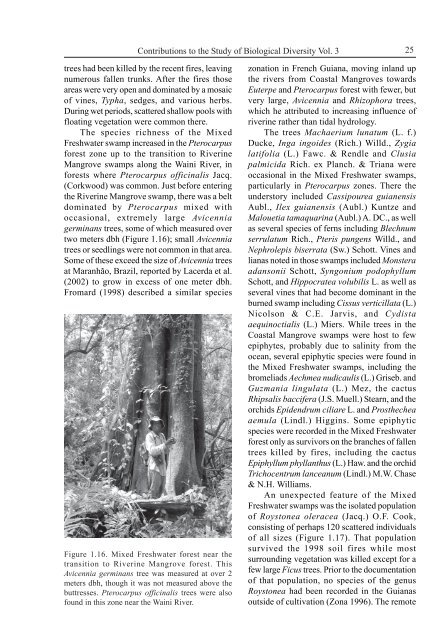Plant Community Structure, Fire Disturbance, and Recovery in ...
Plant Community Structure, Fire Disturbance, and Recovery in ...
Plant Community Structure, Fire Disturbance, and Recovery in ...
You also want an ePaper? Increase the reach of your titles
YUMPU automatically turns print PDFs into web optimized ePapers that Google loves.
Contributions to the Study of Biological Diversity Vol. 3<br />
trees had been killed by the recent fires, leav<strong>in</strong>g<br />
numerous fallen trunks. After the fires those<br />
areas were very open <strong>and</strong> dom<strong>in</strong>ated by a mosaic<br />
of v<strong>in</strong>es, Typha, sedges, <strong>and</strong> various herbs.<br />
Dur<strong>in</strong>g wet periods, scattered shallow pools with<br />
float<strong>in</strong>g vegetation were common there.<br />
The species richness of the Mixed<br />
Freshwater swamp <strong>in</strong>creased <strong>in</strong> the Pterocarpus<br />
forest zone up to the transition to River<strong>in</strong>e<br />
Mangrove swamps along the Wa<strong>in</strong>i River, <strong>in</strong><br />
forests where Pterocarpus offic<strong>in</strong>alis Jacq.<br />
(Corkwood) was common. Just before enter<strong>in</strong>g<br />
the River<strong>in</strong>e Mangrove swamp, there was a belt<br />
dom<strong>in</strong>ated by Pterocarpus mixed with<br />
occasional, extremely large Avicennia<br />
germ<strong>in</strong>ans trees, some of which measured over<br />
two meters dbh (Figure 1.16); small Avicennia<br />
trees or seedl<strong>in</strong>gs were not common <strong>in</strong> that area.<br />
Some of these exceed the size of Avicennia trees<br />
at Maranhão, Brazil, reported by Lacerda et al.<br />
(2002) to grow <strong>in</strong> excess of one meter dbh.<br />
Fromard (1998) described a similar species<br />
Figure 1.16. Mixed Freshwater forest near the<br />
transition to River<strong>in</strong>e Mangrove forest. This<br />
Avicennia germ<strong>in</strong>ans tree was measured at over 2<br />
meters dbh, though it was not measured above the<br />
buttresses. Pterocarpus offic<strong>in</strong>alis trees were also<br />
found <strong>in</strong> this zone near the Wa<strong>in</strong>i River.<br />
25<br />
zonation <strong>in</strong> French Guiana, mov<strong>in</strong>g <strong>in</strong>l<strong>and</strong> up<br />
the rivers from Coastal Mangroves towards<br />
Euterpe <strong>and</strong> Pterocarpus forest with fewer, but<br />
very large, Avicennia <strong>and</strong> Rhizophora trees,<br />
which he attributed to <strong>in</strong>creas<strong>in</strong>g <strong>in</strong>fluence of<br />
river<strong>in</strong>e rather than tidal hydrology.<br />
The trees Machaerium lunatum (L. f.)<br />
Ducke, Inga <strong>in</strong>goides (Rich.) Willd., Zygia<br />
latifolia (L.) Fawc. & Rendle <strong>and</strong> Clusia<br />
palmicida Rich. ex Planch. & Triana were<br />
occasional <strong>in</strong> the Mixed Freshwater swamps,<br />
particularly <strong>in</strong> Pterocarpus zones. There the<br />
understory <strong>in</strong>cluded Cassipourea guianensis<br />
Aubl., Ilex guianensis (Aubl.) Kuntze <strong>and</strong><br />
Malouetia tamaquar<strong>in</strong>a (Aubl.) A. DC., as well<br />
as several species of ferns <strong>in</strong>clud<strong>in</strong>g Blechnum<br />
serrulatum Rich., Pteris pungens Willd., <strong>and</strong><br />
Nephrolepis biserrata (Sw.) Schott. V<strong>in</strong>es <strong>and</strong><br />
lianas noted <strong>in</strong> those swamps <strong>in</strong>cluded Monstera<br />
adansonii Schott, Syngonium podophyllum<br />
Schott, <strong>and</strong> Hippocratea volubilis L. as well as<br />
several v<strong>in</strong>es that had become dom<strong>in</strong>ant <strong>in</strong> the<br />
burned swamp <strong>in</strong>clud<strong>in</strong>g Cissus verticillata (L.)<br />
Nicolson & C.E. Jarvis, <strong>and</strong> Cydista<br />
aequ<strong>in</strong>octialis (L.) Miers. While trees <strong>in</strong> the<br />
Coastal Mangrove swamps were host to few<br />
epiphytes, probably due to sal<strong>in</strong>ity from the<br />
ocean, several epiphytic species were found <strong>in</strong><br />
the Mixed Freshwater swamps, <strong>in</strong>clud<strong>in</strong>g the<br />
bromeliads Aechmea nudicaulis (L.) Griseb. <strong>and</strong><br />
Guzmania l<strong>in</strong>gulata (L.) Mez, the cactus<br />
Rhipsalis baccifera (J.S. Muell.) Stearn, <strong>and</strong> the<br />
orchids Epidendrum ciliare L. <strong>and</strong> Prosthechea<br />
aemula (L<strong>in</strong>dl.) Higg<strong>in</strong>s. Some epiphytic<br />
species were recorded <strong>in</strong> the Mixed Freshwater<br />
forest only as survivors on the branches of fallen<br />
trees killed by fires, <strong>in</strong>clud<strong>in</strong>g the cactus<br />
Epiphyllum phyllanthus (L.) Haw. <strong>and</strong> the orchid<br />
Trichocentrum lanceanum (L<strong>in</strong>dl.) M.W. Chase<br />
& N.H. Williams.<br />
An unexpected feature of the Mixed<br />
Freshwater swamps was the isolated population<br />
of Roystonea oleracea (Jacq.) O.F. Cook,<br />
consist<strong>in</strong>g of perhaps 120 scattered <strong>in</strong>dividuals<br />
of all sizes (Figure 1.17). That population<br />
survived the 1998 soil fires while most<br />
surround<strong>in</strong>g vegetation was killed except for a<br />
few large Ficus trees. Prior to the documentation<br />
of that population, no species of the genus<br />
Roystonea had been recorded <strong>in</strong> the Guianas<br />
outside of cultivation (Zona 1996). The remote
















